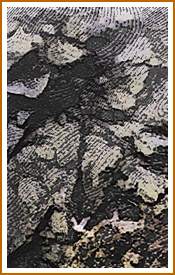|
Everything I do is connected with a love of the land, expressed here by these prints. This is not an empty phrase. I have spent a good deal of my life on farms -- my mother and stepfather
owned farms in Yorkshire in England; as a sculptor, to model in clay is my preferred medium; as a landscape architect I work in a very "hands-on" fashion and see myself happiest as a
working gardener rather than as a landscape designer. I spend a lot of time in my own garden. My experience with the land really is at the root of these prints.
I have lived in the United States for nearly 40 years, but I am still very much aware of my
English background. No one can grow up in England without being party to the special relationship that the English have with their landscape. It is expressed, of course, in their
gardening, but also in their poetry and, most appropriately here, in their painting. One cannot go through an art school education in England without knowing of English landscape painting,
particularly in watercolors.
I am fascinated with the history of landscape
painting. In the right hands, the depiction of a scene does much more than describe a surface appearance or make a pretty picture postcard.
A fine landscape painting looks beyond the immediate and the finite and explores the endless physical world we inhabit and somehow explains our place in it. A
few years ago, I visited a Poussin exhibition. After tiring rooms of allegorical and historical paintings that barely interested me, I came to a large hall entirely
devoted to his landscapes. I stood in the middle of the room and was profoundly moved. I felt a sensation akin to being in a cathedral. This was one man's
exposition of how he saw the Universe, how it was created and how he, and we, fit in.
I have a parallel interest in popular landscape imagery.
As a student I worked in my father's antiquarian book shop, helping with the cataloging. I was always fascinated with the category of "Topography" and the prints that were
produced in the centuries before photography in order to show scenes of noble houses and gardens and views from travels on the Grand Tour. These were often
finely textured aquatints and mezzotints, occasionally hand-colored. As printing technologies became more sophisticated, so developed something of a Golden
Age of British illustration, based largely on creating a painterly feel, but simplified to meet the needs of the printing press. The Grand Tour was replaced by the
poster for the holiday by the seaside and the wonderful prints of quintessentially English countryside hung in railway carriages. The American equivalent was the
glorious poster of the western landscape exhorting people to settle the lands opened up -- and owned -- by the railroad company.
At one shoulder I have a high art that reflects the changes in man's understanding of his world and at the other, a popular art that
reflects a more open society that may not merely dream of remote nature but can actually picnic, or even live there. These twin
fascinations are always in the background. I make no attempt to copy Poussin or the lithographers for the Union Pacific, but they are there in the shadows behind me.
|